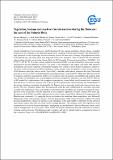Por favor, use este identificador para citar o enlazar a este item:
http://hdl.handle.net/10261/203094COMPARTIR / EXPORTAR:
 SHARE
BASE SHARE
BASE
|
|
| Visualizar otros formatos: MARC | Dublin Core | RDF | ORE | MODS | METS | DIDL | DATACITE | |

| Campo DC | Valor | Lengua/Idioma |
|---|---|---|
| dc.contributor.author | Montoya, Encarnación | - |
| dc.contributor.author | Pedra-Méndez, Jordi | - |
| dc.contributor.author | García-Falcó, Esther | - |
| dc.contributor.author | Stauffer, Fred W | - |
| dc.contributor.author | Montúfar, R. | - |
| dc.contributor.author | Giralt, Santiago | - |
| dc.contributor.author | Gómez-Paccard, Miriam | - |
| dc.contributor.author | Rull, Valentí | - |
| dc.date.accessioned | 2020-03-06T13:58:54Z | - |
| dc.date.available | 2020-03-06T13:58:54Z | - |
| dc.date.issued | 2019-04-07 | - |
| dc.identifier | issn: 1029-7006 | - |
| dc.identifier.citation | Geophysical Research Abstracts, 21: EGU2019-4049 (2019) | - |
| dc.identifier.uri | http://hdl.handle.net/10261/203094 | - |
| dc.description.abstract | Coastal wetlands have been proposed as highly threatened by the ongoing and future climatic change, including projected sea-level changes as an additional forcing factor compared to more inland locations. The limited knowledge generated to date in this topic has been primarily focused in those areas attaining a high population density in the present-day, and rarely deals with long-term (>50 years) dynamics. Here we present the first Holocene palaeoecological study carried in the Orinoco Delta, in NE Venezuela. The record presented here, PATAM18_A12 (9º 30’ N - 62º 41’W, 13 m bsl), contains sediments from the last 6200 years and is located in a river-shore swamp dominated by the palm Mauritia flexuosa. This palm is very abundant in the region, and forms both extensive monospecific and mixed vegetation communities along the river courses. Current human occupation is almost restricted to small settlements of the Warao indigenous culture (known as the boat people), closely related to the use of M. flexuosa (which they refer to as the “tree of life”), and other palm species present in the zone. The results show the occurrence of three well-distinguished palynological zones: (i) from 6200 to 5200 cal yr BP, characterised by mangrove and other taxa related to salinity, low (negative) values of magnetic susceptibility and magnetic grain size, absence of transported clays, and the highest macrocharcoal particles abundance; (ii) from 5200 to 2950 cal yr BP, marked by a replacement of the mangrove vegetation by a more inland mixed-swamp forest community with low levels of charcoal, and (iii) from 2950 cal yr BP to present-day, characterised by the establishment of the current vegetation community, dominated by M. flexuosa, and an increasing trend in the charcoal curve since the last 700 years. Climatic changes have been proposed as the key driver influencing the vegetation succession recorded. The stabilisation of the sea-level that occurred during the mid-Holocene would have favoured the transgression of the coastal line, with the migration of the mangrove vegetation seawards. Around 2800 years ago, the decrease of the ENSO variability registered in the close Cariaco record likely influenced the expansion of the Mauritia palm community. It is suggested that in our location, the inhabiting human populations were differently influenced by these environmental changes. First, the disappearance of the coastal resources could have favoured the land abandonment, whereas the increase in the abundance of the palm might be influential for the arrival of other inland cultures that were previously used to manage Mauritia. This sequence shows the importance of the ecosystem services for the location inhabitants, highlighting the abandonment of the mid-Holocene culture coeval with the disappearance of its ecosystem. These results also provide information about the sensitivity or resilience in facing external stressors of both humans and vegetation, and will be valuable tools for managing the future of this ecosystem. Project refs.: 2014 BP-B-00094 and IJCI-2015-24273. | - |
| dc.language | eng | - |
| dc.publisher | European Geosciences Union | - |
| dc.relation.isversionof | Publisher's version | - |
| dc.rights | openAccess | - |
| dc.subject | Holocene | - |
| dc.subject | Orinoco | - |
| dc.title | Vegetation, humans and sea-level rise interactions during the Holocene: the case of the Orinoco Delta | - |
| dc.type | comunicación de congreso | - |
| dc.relation.publisherversion | https://www.geophysical-research-abstracts.net/egu2019.html | - |
| dc.date.updated | 2020-03-06T13:58:54Z | - |
| dc.rights.license | https://creativecommons.org/licenses/by/4.0/ | - |
| dc.relation.csic | Sí | - |
| dc.type.coar | http://purl.org/coar/resource_type/c_5794 | es_ES |
| item.grantfulltext | open | - |
| item.cerifentitytype | Publications | - |
| item.openairecristype | http://purl.org/coar/resource_type/c_18cf | - |
| item.fulltext | With Fulltext | - |
| item.openairetype | comunicación de congreso | - |
| Aparece en las colecciones: | (Geo3Bcn) Comunicaciones congresos | |
Ficheros en este ítem:
| Fichero | Descripción | Tamaño | Formato | |
|---|---|---|---|---|
| Montoya_EGU2019-4049.pdf | 37,08 kB | Adobe PDF |  Visualizar/Abrir |
CORE Recommender
Page view(s)
122
checked on 16-abr-2024
Download(s)
36
checked on 16-abr-2024
Google ScholarTM
Check
Este item está licenciado bajo una Licencia Creative Commons

